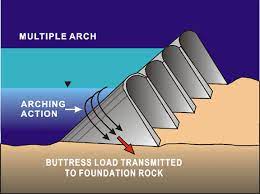Buttress Dams: Difference between revisions
From ASDSO Dam Safety Toolbox
Rmanwaring (talk | contribs) No edit summary |
No edit summary |
||
| Line 10: | Line 10: | ||
|caption= | |caption= | ||
<!-- Add picture caption --> | <!-- Add picture caption --> | ||
A diagram displaying how forces are transferred through the structure's buttress design. ([https://www.usbr.gov/ssle/damsafety/risk/BestPractices/Presentations/E5-ButtressDamsPP.pdf USBR, 2019]) | A diagram displaying how forces are transferred through the structure's buttress design. | ||
(Photo Source: [https://www.usbr.gov/ssle/damsafety/risk/BestPractices/Presentations/E5-ButtressDamsPP.pdf USBR, 2019]) | |||
}} | }} | ||
Latest revision as of 20:28, 18 July 2023

|
| A diagram displaying how forces are transferred through the structure's buttress design.
(Photo Source: USBR, 2019) |
A buttress dam is a specific type of gravity dam in which the large mass of concrete or masonry is reduced, and the forces are diverted to the dam foundation through vertical or sloping buttresses. Buttress dams are also referred to as multiple arch dams or Ambursen dams after engineer Nils F. Ambursen who developed and patented the design technique in the early 1900's.
Life Cycle of Buttress Dams
Best Practices Resources
![]() Engineering Guidelines for the Evaluation of Hydropower Projects: Chapter 10- Other Dams, FERC, 1997
Engineering Guidelines for the Evaluation of Hydropower Projects: Chapter 10- Other Dams, FERC, 1997
Revision ID: 7311
Revision Date: 07/18/2023
